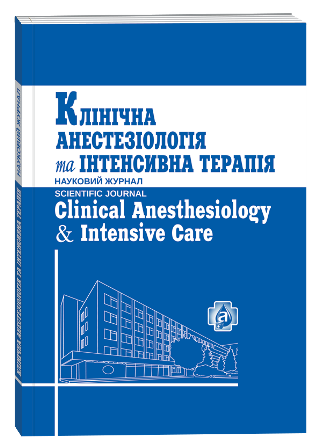ANTIFIBRINOLYTIC THERAPY IN BLEEDINGS ASSOCIATED WITH PLACENTAL ABRUPTION
Keywords:
placental abruption, hemostasis, fibrinolysis, aprotinin, tranexamic acidAbstract
Background. Comparative evaluation of efficacy of aprotinin and tranexamic acid on the effect of hemostasis, fibrinolysis, the degree of blood loss. The choice of methods of diagnosis, prevention and correction of complex disorders of hemostasis in women with placental abruption in the perioperative period. Materials and methods. There studied the results of fibrinolysis inhibitor therapy in women after cesarean section with placental abruption. Patients were divided into 3 groups: the first group of patients were not received antifibrinolytic drugs, the second group of patients were infused aprotinin 300,000 KIU, the third group of patients were received tranexamic acid 15 mg/kg during the operation. Assessment of the degree of blood loss was conducted at the end of the first postoperative day, and accounted the pre-, intra- and postoperative blood loss. Status hemostasis controlled by the low-frequency piezoelectric vibrating hemoviscosimetry. Results. The study data were obtained about more pronounces antifibrinolytic and blood preserving effect of the tranexamic acid, which was reflected in the reduction of perioperative blood loss in the group with aprotinin and tranexamic acid to 21.6 and 34.2 % respectively. When using aprotinin there was the increase of the plasma coagulation potential. Conclusions. Early application of fibrinolysis inhibitors in placental abruption is pathogenetically justified and necessary, helping to reduce perioperative blood loss. The use of the method of low-frequency vibrating piezoelectric hemoviscosimetry in obstetric bleedings enables to reveal disturbances in different parts of the hemostasis system intraoperatively and reliably that allows to make their correction timely and fully.
References
Шифман Е. М. Инфузионно-трансфузионная терапия в акушерстве / Е. М. Шифман, А. Д. Тиканадзе, В. Я. Вартанов. – Петрозаводск : ИнтелТек, 2004. – 304 с.
Про затвердження клінічних протоколів з акушерської та гінекологічної допомоги. Наказ МОЗ України № 676 від 31.12.2004. – К., 2005. – 183 с.
Сидорова И. С. Кровотечения во время беременности и в родах / И. С. Сидорова, И. О. Макаров. – М. : МИА, 2006. – 121 с.
Масивні акушерські кровотечі / В. В. Камінський, О. В. Голяновський, Р. О. Ткаченко, А. В. Чернов. – К. : Тріумф, 2010. – 232 с.
Reduced blood loss during Ceaserean section under the action of tranexamic acid / Tarabrin O., Galich S., Tkachenko R. [et al.] // European Journal of Anaesthesiology. 2012. – Vol. 29. – P. 97.
Макацария А. Д. Тромбозы и тромбоэмболии в акушерской и гинекологической практике / А. Д. Макацария, В. О. Бицадзе, С. В. Акиньшина. – М. : МИА, 2007. – 1064 с.
Зильбер А. П. Акушерство глазами анестезиолога / А. П. Зильбер, Е. М. Шифман. – Петрозаводск, 1997. – 397 с.
Анестезия и реанимация в акушерстве и гинекологии / В. И. Кулаков, В. Н. Серов, А. М. Абакирова [и др.] – М. : Триада-Х, 2000. – 384 с.







